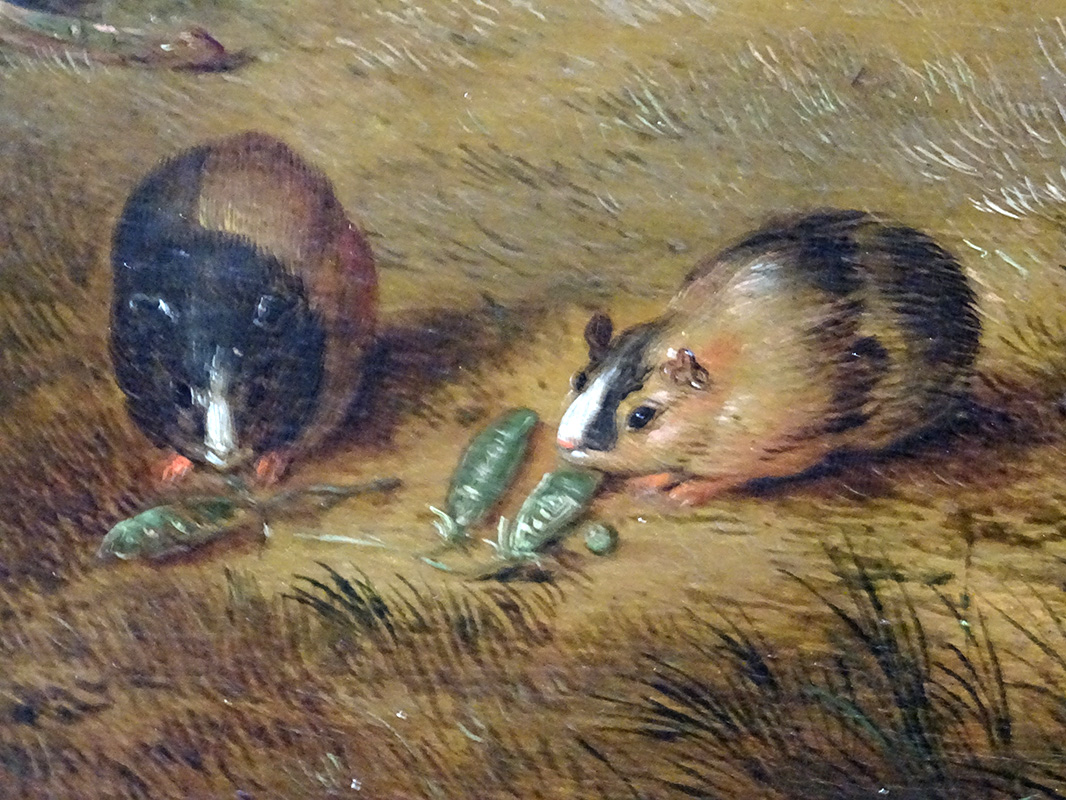We may trace the guinea pig’s global career via representations of the animal in art. Jan Brueghel’s The Feast of Bacchus (c.1640) represents two guinea pigs nibbling on a pea pod. Teodor Lubieniecki’s Still Life with Guinea Pigs (late 17th century) depicts two of the animals peering at a basket of fruit, while Albert Eckhout’s portrait of a Brazilian mameluca (1641) has a pair of guinea pigs emerging from the undergrowth. Other notable guinea pig artworks include a miniature by Flemish artist David de Coninck, which features two plump cuyes sniffing a bunch of grapes; Felice Boselli’s Still Life with a Pigeon and Guinea Pig (c.1690) and Jakab Bogdány’s Capuchin Squirrel Monkey, Two Guinea Pigs, a Blue Tit and an Amazon St Vincent Parrot with Peaches, Figs and Pears in a Landscape (1710–20), in which two inquisitive guinea pigs inspect a pear. One portrait of three children by an unknown artist depicts a seven-year-old girl cradling a podgy cuy in her arms, while a boy next to her clutches a bird. Dated around 1580, this is believed to be the oldest English representation of a guinea pig and suggests the early adoption of the animal among elites as a pet. It is notable that in many of these paintings, guinea pigs are portrayed in the act of eating.
GUINEA PIG ART
Helen Cowie
Further reading
- Acosta, J. (2002) Natural and Moral History of the Indies [1589], edited by J. Mangan, translated by F. López-Morillas (Durham, NC: Duke University Press).
- Asúa, M., and R. French (2005) A New World of Animals: Early Modern Europeans on the Creatures of Iberian America (Aldershot, Hampshire: Ashgate Publishing).
- Crosby, A. (1972) The Columbian Exchange: Biological and Cultural Consequences of 1492 (Westport, CT: Greenwood Press).
- Cumberland, C. (1886) The Guinea Pig, or Domestic Cavy, for Food, Fur and Fancy (London: L. Upcott Gill).
- Defrance, S. (2006) ‘The sixth toe: the modern culinary role of the guinea pig in southern Peru’, Food and Foodways, 14 (1): 3–34.
- Few, M., and Z. Tortorici (eds.) (2014) Centering Animals in Latin American History (Durham, NC: Duke University Press).
- Gade, D. (1967) ‘The guinea pig in Andean folk culture’, Geographical Review, 57 (2): 213–24.
- Maas, B. (2019) ‘Why more people in Africa should farm guinea pigs for food’, The Conversation, https://theconversation.com/why-more-people-in-africa-should-farm-guinea-pigs-for- food-108477.
- Morales, E. (1994) ‘The guinea pig in the Andean economy: from household animal to market commodity’, Latin American Research Review, 29 (3), 129–42.
- Parker Brienen, R. (2006) Visions of Savage Paradise: Albert Eckhout, Court Painter in Colonial Dutch Brazil (Amsterdam: Amsterdam University Press).
- Sandweiss, D., and E. Wing (1997) ‘Ritual rodents: the guinea pigs of Chincha, Peru’, Journal of Field Archaeology, 24 (1): 47–58.
- Yamamoto, D. (2015) Guinea Pig (London: Reaktion Books).





